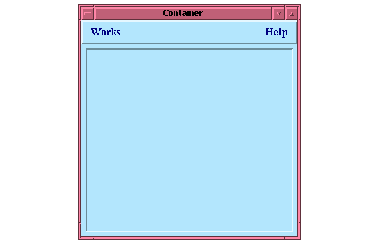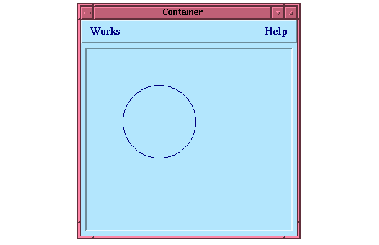





9 Creating Your Own Panes
9.1 Displaying graphics
The following is a simple example demonstrating how to create an output-pane and then how to draw a circle on it.
(setq output-pane
(contain
(make-instance 'output-pane)
:best-width 300
:best-height 300))

Figure 9.1 An empty output pane
Now you can draw a circle in the empty output pane by using thedraw-circle function from the graphics package.
(gp:draw-circle output-pane 100 100 50)

Figure 9.2 An output pane containing a circle
Notice that this circle is not permanently drawn on the output-pane, and when the window is next redisplayed it vanishes. To prove this to yourself, force the window to be redisplayed (for example by iconizing or resizing it). At this point, you can draw the circle again yourself but it will not happen automatically.
(gp:draw-circle output-pane 100 100 50)
In order to create a permanent display, you need to provide a function to the output-pane that is called to redraw sections of the output-pane when they are exposed. This function is called the display callback. When the CAPI needs to redisplay a region of an output-pane, it calls that output-pane's display-callback function, passing it the output-pane and the region in question. For example, to create a pane that has a permanent circle drawn inside it, do the following:
(defun draw-a-circle (pane x y
width height)
(gp:draw-circle pane 100 100 50))
(contain
(make-instance
'output-pane
:display-callback 'draw-a-circle)
:best-width 300
:best-height 300)
Notice that the callback in this example ignores the region that needs redrawing and just redraws everything. This is possible because the CAPI clips the drawing to the region that needs redisplaying, and hence only the needed part of the drawing gets done. For maximum efficiency, it would be better to only draw the minimum area necessary. The keywords:best-width and:best-height keywords specify the initial width and height of the circle pinboard object. More detail can be found in the CAPI Reference Manual. Now that we can create output-panes with our own display functions, we can create a new class of window by using defclass as follows.
(defclass circle-pane (output-pane)
()
(:default-initargs
:display-callback 'draw-a-circle))
(contain
(make-instance 'circle-pane))
CAPI User Guide, Liquid Common Lisp Version 5.0 - 2 OCT 1997 





Generated with Harlequin WebMaker







